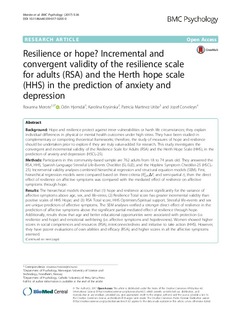| dc.contributor.author | Morote, Roxanna | |
| dc.contributor.author | Hjemdal, Odin | |
| dc.contributor.author | Krysinska, Karolina | |
| dc.contributor.author | Uribe, Patricia Martinez | |
| dc.contributor.author | Corveleyn, Jozef | |
| dc.date.accessioned | 2018-06-28T11:12:21Z | |
| dc.date.available | 2018-06-28T11:12:21Z | |
| dc.date.created | 2017-11-03T15:55:48Z | |
| dc.date.issued | 2017 | |
| dc.identifier.citation | BMC Psychology. 2017, 5 (36). | nb_NO |
| dc.identifier.issn | 2050-7283 | |
| dc.identifier.uri | http://hdl.handle.net/11250/2503566 | |
| dc.description.abstract | Background: Hope and resilience protect against inner vulnerabilities or harsh life circumstances; they explain individual differences in physical or mental health outcomes under high stress. They have been studied in complementary or competing theoretical frameworks; therefore, the study of measures of hope and resilience should be undertaken prior to explore if they are truly value-added for research. This study investigates the convergent and incremental validity of the Resilience Scale for Adults (RSA) and the Herth Hope Scale (HHS), in the prediction of anxiety and depression (HSCL-25). Methods: Participants in this community-based sample are 762 adults from 18 to 74 years old. They answered the RSA, HHS, Spanish Language Stressful Life-Events Checklist (SL-SLE), and the Hopkins Symptom Checklist-25 (HSCL- 25). Incremental validity analyses combined hierarchical regression and structural equation models (SEM). First, hierarchical regression models were compared based on three criteria (R2 Diff.,ΔF, and semi-partial r), then the direct effect of resilience on affective symptoms was compared with the mediated effect of resilience on affective symptoms through hope. Results: The hierarchical models showed that (1) hope and resilience account significantly for the variance of affective symptoms above age, sex, and life-stress; (2) Resilience Total score has greater incremental validity than positive scales of HHS Hope; and (3) RSA Total score, HHS Optimism/Spiritual support, Stressful life-events and sex are unique predictors of affective symptoms. The SEM analyses verified a stronger direct effect of resilience in the prediction of affective symptoms above the significant partial mediated effect of resilience through hope. Additionally, results show that age and better educational opportunities were associated with protection (i.e. resilience and hope) and emotional well-being (i.e. affective symptoms and hopelessness). Women showed higher scores in social competences and resources (RSA), interconnectedness and initiative to take action (HHS). However, they have poorer evaluations of own abilities and efficacy (RSA), and higher scores in all the affective symptoms assessed. Conclusion: The RSA has incremental validity above the HHS, however, both the RSA and the HHS are effective, differentiated and complementary measures of protection that are of high relevance for research on psychosocial and emotional well-being. Keywords: Resilience, Hope, Anxiety, Depression, Incremental validity, SEM | nb_NO |
| dc.language.iso | eng | nb_NO |
| dc.publisher | Springer Nature/ BioMed Central | nb_NO |
| dc.rights | Navngivelse 4.0 Internasjonal | * |
| dc.rights.uri | http://creativecommons.org/licenses/by/4.0/deed.no | * |
| dc.subject | Psykisk helse / mental helse | nb_NO |
| dc.subject | Mental Health | nb_NO |
| dc.subject | Robusthet | nb_NO |
| dc.subject | Resilience | nb_NO |
| dc.title | Resilience or hope? Incremental and convergent validity of the resilience scale for adults (RSA) and the Herth hope scale (HHS) in the prediction of anxiety and depression | nb_NO |
| dc.type | Journal article | nb_NO |
| dc.type | Peer reviewed | nb_NO |
| dc.description.version | publishedVersion | nb_NO |
| dc.subject.nsi | VDP::Kognitiv psykologi: 267 | nb_NO |
| dc.subject.nsi | VDP::Cognitive psychology: 267 | nb_NO |
| dc.source.pagenumber | 13 | nb_NO |
| dc.source.volume | 5 | nb_NO |
| dc.source.journal | BMC Psychology | nb_NO |
| dc.source.issue | 36 | nb_NO |
| dc.identifier.doi | 10.1186/s40359-017-0205-0 | |
| dc.identifier.cristin | 1510860 | |
| dc.description.localcode | © The Author(s). 2017 Open Access This article is distributed under the terms of the Creative Commons Attribution 4.0 International License (http://creativecommons.org/licenses/by/4.0/), which permits unrestricted use, distribution, and reproduction in any medium, provided you give appropriate credit to the original author(s) and the source, provide a link to the Creative Commons license, and indicate if changes were made. The Creative Commons Public Domain Dedication waiver (http://creativecommons.org/publicdomain/zero/1.0/) applies to the data made available in this article, unless otherwise stated | nb_NO |
| cristin.unitcode | 194,67,40,0 | |
| cristin.unitname | Institutt for psykologi | |
| cristin.ispublished | true | |
| cristin.fulltext | original | |
| cristin.qualitycode | 1 | |

